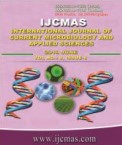


 National Academy of Agricultural Sciences (NAAS)
National Academy of Agricultural Sciences (NAAS)

|
PRINT ISSN : 2319-7692
Online ISSN : 2319-7706 Issues : 12 per year Publisher : Excellent Publishers Email : editorijcmas@gmail.com / submit@ijcmas.com Editor-in-chief: Dr.M.Prakash Index Copernicus ICV 2018: 95.39 NAAS RATING 2020: 5.38 |
Shrimp aquaculture has become an economically important one and production has decreased in recent years due to the spread of infectious diseases, mostly that caused by bacterial infection. The shrimp are affected by the toxic substances which eventually enter in to their systems and bring about external damages. This study explores, it was aimed to assessment of the physiochemical and microbiological quality of different farmed shrimp from Ratnagiri. The results of this attempt for the study such as sensory, physicochemical, proximate composition and microbiological quality of shrimp Litopenaeus vannamei cultured in three different farms of Ratnagiri were compared. Fresh shrimps were analyzed for sensory attributes where, natural and bright colour, excellent odour, elastic and rigid texture with very good appearance was observed. The highest protein content (17.6%) was observed in samples collected from Varavde farm and lowest (16.8%) was observed in the samples collected from Ranpar farm. The highest fat content was found in the samples collected from Nevre farm i.e. 1.5% and lowest was found in the samples collected from Ranpar farm i.e. 1.3%. The highest moisture content was recorded in the samples of Ranpar farm i.e. 77.9% and lowest was recorded in the samples of Varavde farm i.e. 73.2%. The highest and lowest ash content was observed in the sample collected from Ranpar farm i.e. 1.9% and 1.4% respectively. The carbohydrate content was higher in the samples (2.4%) collected from Varavde farm and lowest in the samples of Nevre farm (1.5%). The TMA level in the sample collected from Ranpar, Nevre and Varavde farm was ranged between 2.2 to 2.4 mg/100g, 2.4 to 3.0 mg/100 g and 3.2 to 3.3 mg/100g respectively. TVB-N levels of fresh shrimp sample collected from Ranpar and Varavde farm ranged between 11.1 to 13.6 mg/100g, 13.0 to 13.1 mg/100 g respectively. The value estimated from the sample collected from Nevare farm was 13.0 mg/100g. Peroxide value of fresh shrimp sample collected from Ranpar, Nevare and Varavde farm ranged between 3.7 to 4.3 meq of O2/Kg, 3.3 to 4.7 meq of O2/Kg and 2.3 to 3.3 meq of O2/Kg respectively. Total bacterial count of samples collected from Ranpar, Nevare and Varavde showed an increasing trend during study period. Highest bacterial count was detected in the sample collected from Ranpar farm i.e. 1.03×106. An increase in the Staphylococcus count was observed throughout the study period at Ranpar and Varavde site; whereas a slight decrease was observed during second sampling at Nevare site. Salmonella, E. coli and L. monocytogenes was not detected in any sample throughout the study. So the present study revealed that the hygienic condition of the investigated shrimp farm was good on the basis of microbiological analysis.
 |
 |
 |
 |
 |